Ipoh shredded chicken noodles (怡保河粉/Ipoh Hor Fun) are soup noodles served with an exotic broth prepared from chicken bones and shrimp shells. The rich broth has an incredibly savory flavor and tantalizing aroma. It has a signature look with a vivid layer of reddish shrimp oil floating on top.
What is Ipoh shredded chicken noodles? The noodles are called 怡保鸡丝河粉 (pronounced as Ipoh gai si Hor Fun or Ipoh kai si hor fun) in Cantonese. As the name suggests, these noodles are the specialty of Ipoh, a city in northwestern Peninsula Malaysia, which is also the capital of the state of Perak. This article will explain in detail how to prepare the Ipoh Hor Fun from scratch. It takes time and effort, but I guarantee that it is worth all the hard work you put in.
Note: This post may contain affiliate links. Please read my privacy policy for more info. I may receive commissions for purchases made through links in this post. As an Amazon Associate, I earn from qualifying purchases.
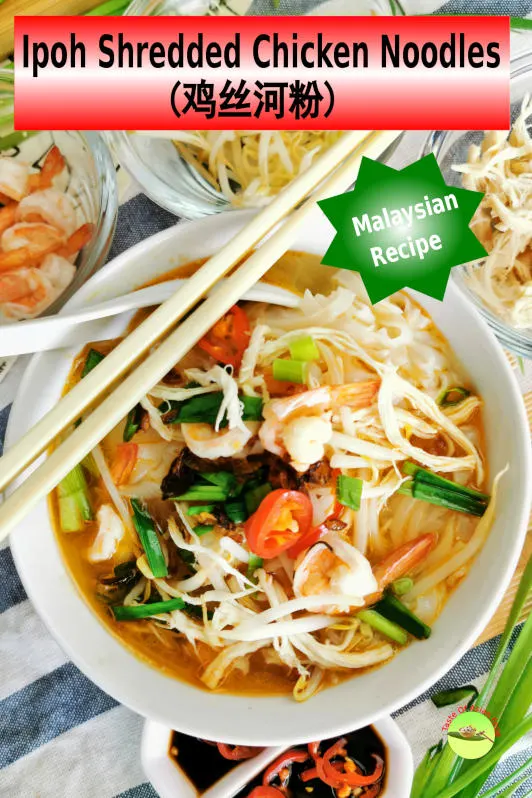
The main ingredients for making Ipoh Hor Fun (chicken noodles)
- Hor Fun. These flat rice noodles are the specialty of Ipoh. Fresh rice noodles have a silky smooth texture and usually is readily available at any wet market or supermarket. It is the thinner variety that is used as the thicker type is more suitable for frying. You can substitute it with the dry version if it is unavailable where you live. Follow the packet instructions to cook it until al dente before use. Alternatively, you can use Chinese egg noodles, although that is not the traditional way they are served in Ipoh.
- Chicken bones. You need chicken bones to make this tasty broth. I use the chicken carcasses purchased from the local market and supermarket. You can improvise it by using leftover roast chicken bones if you don’t have them.
- Shrimp heads. Shrimp heads are also readily available at the local wet market. The locals use it to prepare another famous street food called Penang prawn mee. Some home cooks collect and freeze the shrimp heads whenever they cook shrimp. They will cook this dish after they gather enough shrimp shells and heads. You can do the same, but I have purchased 1.4kg of shrimp today and managed to get 500g of heads. I only use part of the shrimp meat in this recipe and keep the remainder for my shrimp and asparagus stir-fry and shrimp fried rice. The broth made with shrimp heads is delightful, and even better if it’s stir-fried until aromatic before adding it to the simmering pot of water.
- Chicken meat. As the name suggests, hor fun is served with shredded chicken. The chicken breast should be boneless and skinless, and poached in the slow-boiling broth until just cooked. Rapid boiling will toughen the meat. Once the chicken breast is cooked, remove it from the broth, let it cool, shred it into thin threads, and place it on the noodles before serving. You can also use chicken thigh meat, which is more tender and juicier. Some noodles restaurants also include Chinese barbeque pork (char siew) besides chicken meat.
- Shrimp meat. The last primary ingredient is shrimp meat. I like to keep the end section of the shrimp shell (the tail) intact because it is more visually appealing. Alternatively, remove all the shells and halve the shrimp lengthwise. The deveined and shelled shrimps are pouched in the broth. Once cooked, set aside to be used later.
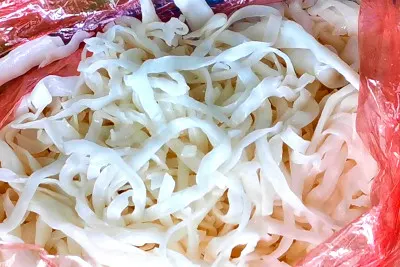
The supporting ingredients
The following are the supporting ingredients. Don’t take it lightly if you want to make a bowl of superior Ipoh Hor Fun.
- Bean sprouts. Ipoh has the best quality bean sprouts due to the abundance of hard water from the limestone hills surrounding it, which contributes to the growth of crunchy and succulent bean sprouts. You may not have the luxury of finding such high-quality bean sprouts where you live, but they are a crucial ingredient for getting close to the original recipe.
- Deep-fried shallots. They are used abundantly in Malaysian cuisine. Sprinkle the fried shallots liberally on top of the noodles. This is the way to add more flavor. You can purchase it from an Asian grocery store or make it by following this recipe.
- Chives and spring onions. Both greens are added to the noodles, making it more colorful. Besides that, some restaurants include other Chinese greens, such as choy sum (cai xin / 菜心).
- Rock sugar. Rock sugar is an elusive ingredient for most non-Asian. The purist vouch that it has a cleaner taste and without the caramel tone. It is widely used to prepare a Chinese dessert called tong sui 糖水, such as red bean soup. The flavor without the caramel tone is preferred by most Chinese. Since it’s a personal preference, I’ll leave it to you to decide whether you want to use rock sugar or regular sugar. I have tried that before, and the difference is insignificant.
- Seasoning and Garnish. The seasonings are kept to a minimum. These are basic ingredients: light soy sauce, dark soy sauce, salt, and white pepper.
- Others. Besides the spring onions, chive, and fried shallots, cut a few slices of red chili to add some color to the whole ensemble. The noodles are best served with some soy sauce and cut chili.
Ipoh hor fun is also called shredded rice noodles, 怡保河粉, 鸡丝河粉, and flat rice noodles. It is slightly confusing when translated, so I just list all the variations to assure you that they mean the same thing.
How to make the Ipoh shredded chicken noodles (flat rice noodles/hor fun)?
You can prepare Ipoh Hor Fun with authentic flavor because the ingredients are readily available anywhere.
1. To make the broth
a. Simmer the chicken bones
- Wash the chicken bones with water and remove all the debris. (Note: Some stores also add some pork bones to enhance the flavor.)
- Place the bones in a stockpot and fill it with a large pot of water that is enough to cover all the bones. Bring the cold water to a boil, then reduce the heat to a bare simmer.
- Skim away the scum floating on the surface to get a clear chicken stock.
- Add the peppercorns and let them simmer over low heat for 1 hour, or until the bones are soft and release all their flavor.
b. Stir-fry and simmer the shrimp heads
- Wash the shrimp heads. Drain.
- Heat sufficient oil in a pan. It is intended to use more oil to fry the shrimp heads, which will produce more shrimp oil to drizzle on the noodles later.
- Stir-fry the shrimp heads until they are fragrant and turn golden, which takes about 15-20 minutes.
- Strain the shrimp heads and set aside the excess shrimp oil.
- Add the fried shrimp heads to the chicken broth and simmer over low heat for 20 minutes until the shrimp flavor is fully extracted.
- Remove the shrimp heads and chicken bones by filtering the broth through a fine sieve. For an extra clean result, filter it again through a cloth bag or cheesecloth.
- Season with rock sugar and salt. You need to use more salt because it will be served together with the noodles.
2. Prepare the shredded chicken and shrimp
- Simmer the chicken meat in the clear broth we prepare just now for 15 minutes. Do not use high heat for cooking the chicken as it will toughen the meat.
- Remove the chicken once it is cooked, i.e., when it reaches an internal temperature of 70 °C (160°F). Once the chicken is cold, shred it to become chicken floss.
- Put the shrimp into a small colander and poach it in the broth. Remove and set aside when they are cooked.
3. Deep-fried the shallots (or store-bought)
- Frying the shallots is quite straightforward. First, slice the shallots thinly.
- Next, deep-fry the shallots in hot oil over low heat until it turns golden brown and crispy. It’s better to use low heat to avoid rapid browning, which takes about 10 minutes.
- After it becomes crispy and golden, pour it through a wire mesh strainer to remove the excessive oil. You can use the shallot oil to fry the shrimp heads.
- When it is cold, keep the fried shallots in an airtight container.
There are ready-made fried shallots available in the market and supermarkets in Malaysia. I’m unsure whether it’s available in other places, but you can buy it online from Amazon.
4. Assemble and serve
Now it’s time for the final part: assembling everything into one bowl.
- Place the hor fun in a colander and blanch in hot water for twenty seconds. Shake off the excess water and place the noodles in a bowl. (If you’re using the dried type, boil them in hot water until they’re al dente, similar to cooking pasta.)
- Blanch the bean sprouts and chives in water for twenty seconds. Do not cook the bean sprouts for too long to keep them crunchy.
- Put the hot hor fun in a large bowl and top with the chicken meat, bean sprouts, shrimp, fried shallots, chives, red chili, and spring onions.
- Ladle the hot broth over the noodles. Add a teaspoon of the reserved shrimp oil. Serve immediately with light soy sauce and green chili.
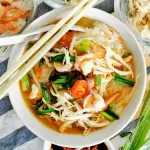
Ipoh shredded chicken noodles
If you are living in Malaysian, you must have heard of the famed Ipoh shredded chicken noodles.
It is called 鸡丝河粉(pronounce as Gai Si Hor Fun) and 怡保河粉 in Cantonese. Hor fun is locally produced flat rice noodles, with a silky texture which is due to the
Ingredients
- 200g (7 oz) shrimp meat
- 400g (0.8 lb) chicken breast
- 1kg (2 lbs) flat rice noodles (Hor Fun)
- 1 Cup Bean Sprouts
- 100 g (4 oz) chives, cut into 3 cm segments
- 3 stalks of scallions, cut into short sections
- 3 stalks of chives
- 3 fresh red chilies, sliced
- 4 tbsp crispy fried shallots
Soup Base
- 1.4 kg (3lbs) chicken bones
- Sufficient water to submerge the chicken
- 1 Tbsp Whole White Peppercorns
- 30g (1 oz) rock Sugar
- 2 tsp Salt
- 500g (1 lb) Shrimp Shells
- 100ml (3.5 oz) cooking oil ( for frying the shrimp heads)
Instructions
Chicken and shrimp broth
- Pace the chicken bones in a pot with cold water enough to cover all the bones. Skim away the scum floating on the surface. Add the peppercorn. Simmer over low heat for one hour.
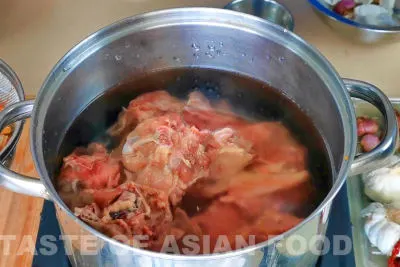
- Stir-fry the shrimp heads until fragrant and turn golden, which takes about 15 to 20 minutes. Strain the shrimp heads and keep the excess shrimp oil separately.
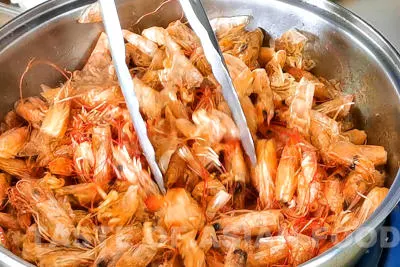
- Add the fried shrimp heads to the chicken broth and simmer over low heat for 20 minutes.
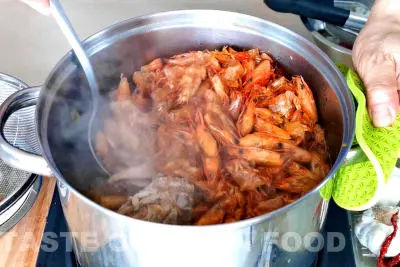
- Strain the broth with a strainer or cloth bag. Season with rock sugar and salt.
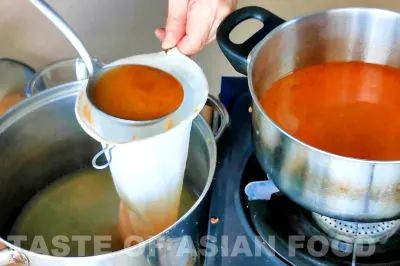
Others
- Simmer the chicken breast meat in the clean stock until it is cooked, which takes about 15 minutes.
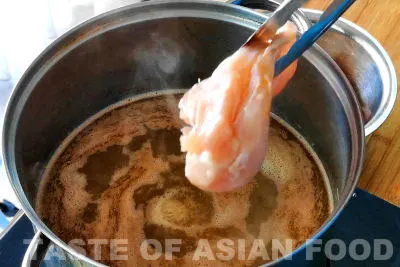
- Shred to become chicken floss.
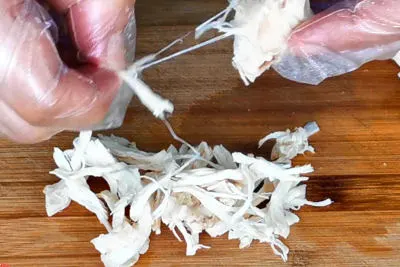
- Poach the shrimp in the broth. Set aside.
- Slice the shallots thinly. Deep-fried over low heat until crispy and brown. Pour it through a wire mesh strainer to remove the excessive oil.
To assemble
- Blanch the noodles, bean sprouts, and chives separately in hot water for 20 seconds.
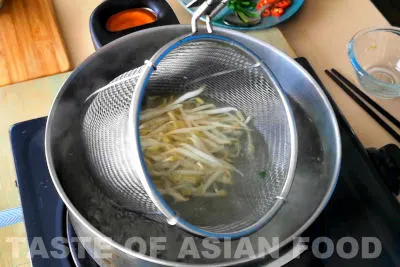
- Put the hot hor fun in a large bowl, top with the shredded chicken, bean sprouts, shrimps, fried shallots, chives, red chili, and scallions. Ladle the hot stock over the noodles. Add a teaspoon of the fragrant shrimp oil and serve immediately.
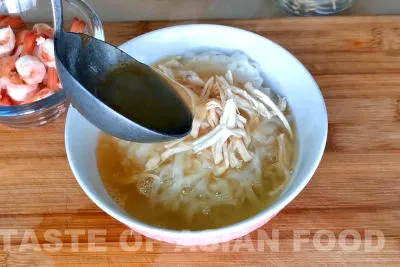
Recommended Products
As an Amazon Associate and member of other affiliate programs, I earn from qualifying purchases.
Nutrition Information:
Yield: 5 Serving Size: 1Amount Per Serving: Calories: 240Total Fat: 10gSaturated Fat: 2gTrans Fat: 0gUnsaturated Fat: 7gCholesterol: 39mgSodium: 1148mgCarbohydrates: 23gFiber: 2gSugar: 4gProtein: 14g
This data was provided and calculated by Nutritionix on 6/6/2020
Frequently asked questions:
- Should I add oyster sauce to enhance the flavor of the broth? Oyster sauce is unnecessary, and I would avoid using it as it will make the taste less authentic.
- Can I use instant stock purchases from the grocery store instead of making the broth from scratch? The broth is the soul of the noodle dish. It should be done from scratch. Since there is no store-bought prawn stock available, I suggest not taking the shortcut but making it yourself.
If you like this Ipoh hor fun recipe, you are likely also interested in making other Asian recipes like the Vietnamese pho and the Hong Kong wonton noodles soup. Please refer to the recipes on this blog if you want to try them.

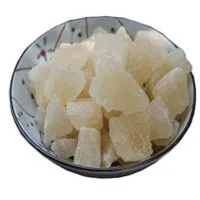
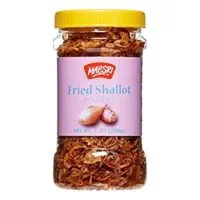
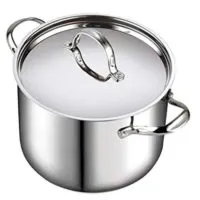
Garlic Shrimp with Rice: Quick and Satisfying One-Dish Meal
Wednesday 20th of August 2025
[…] and strain. Store in an airtight container for soups or stir-fries. I use this stock to make Ipoh Hor Fun and Prawn Mee. Check out the recipe if you’d like to try these comforting Malaysian noodle […]
Ruby Yeoh
Monday 21st of April 2025
Thanks for the Ipoh Hor Fun recipe. I made it last week and it was very good. Looking at your recipe its more or less the same using the specified ingredients you mentioned. Thanks so much for sharing. Happy Cooking.
Shrimp and glass noodles in clay pot recipe | 鲜虾粉丝煲
Tuesday 12th of November 2024
[…] Ipoh shredded chicken noodles (怡保河粉). The broth of this soup noodles is also made with shrimp shell and head, plus chicken bones. […]
Ayam goreng - How to make authentic Malaysian fried chicken
Friday 1st of November 2024
[…] you are living in Malaysia, you must have heard of the famed Ipoh shredded chicken noodles. Reserve any chicken bones and shrimp shells to make the broth for the noodles. The flavor is […]
Yi Mein (yee mee / 伊面) - Cantonese noodles recipe - Taste Of Asian Food
Tuesday 24th of September 2024
[…] Ipoh shredded chicken noodles (怡保河粉) […]